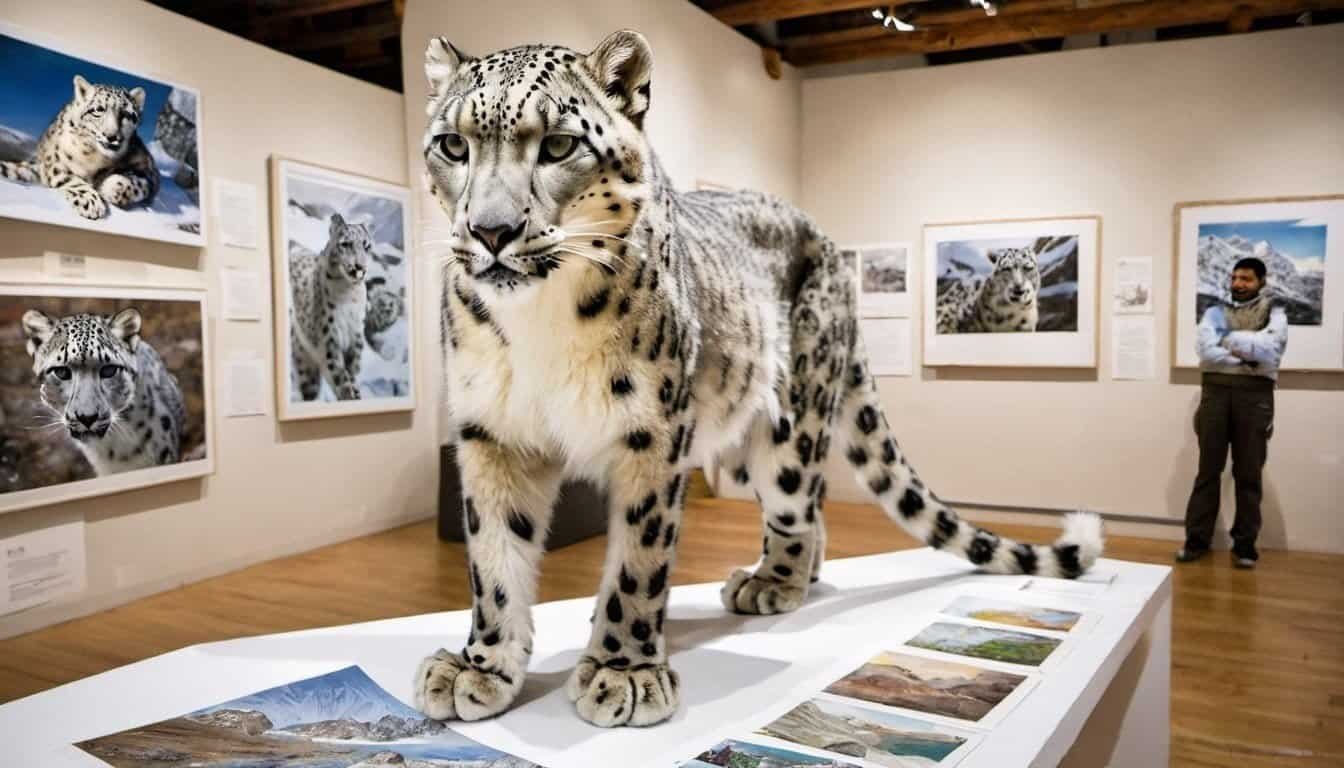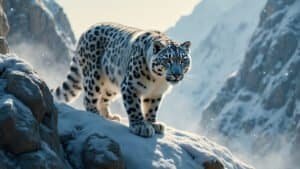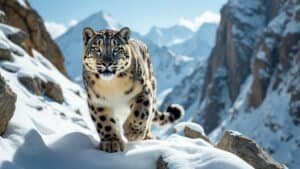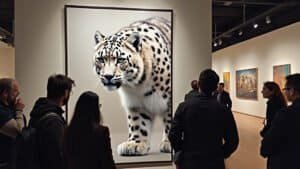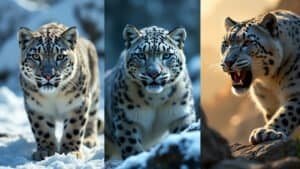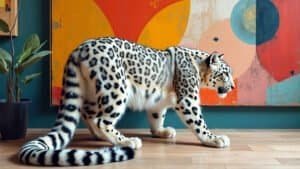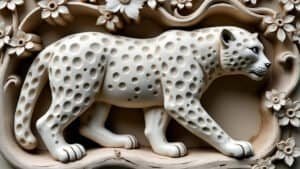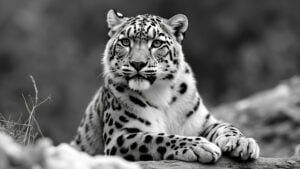Introduction
Snow leopard-themed art exhibitions have emerged as powerful tools in the realm of wildlife conservation, drawing attention to the plight of this elusive species. These exhibitions blend artistic expression with environmental advocacy, creating unique experiences that captivate audiences while delivering critical messages about conservation
Throughout this article, we will explore how these art exhibitions attract public interest, the messages they convey, their impact on conservation efforts, and the collaboration between artists and conservationists
Additionally, we’ll delve into the challenges faced by organizers and the overall effectiveness of these exhibitions in raising awareness and promoting action for snow leopard conservation
How Snow Leopard-Themed Art Exhibitions Attract Public Interest
Snow leopard-themed art exhibitions are increasingly being recognized as impactful events that blend the allure of art with the urgency of conservation
These exhibitions, often hosted in major cities or cultural hubs, draw in diverse audiences ranging from art enthusiasts to environmental activists
The combination of stunning visuals and a compelling cause creates an engaging environment that not only captivates visitors but also motivates them to learn more about the endangered snow leopard
The Role of Artistic Creativity in Capturing Attention
Artistic creativity plays a crucial role in drawing people to snow leopard-themed exhibitions. Artists use various mediums, including painting, sculpture, and digital art, to depict the beauty and majesty of snow leopards
The artwork often highlights the animal’s enigmatic nature, with a focus on its camouflage in the snow-capped mountains or its intense gaze. This artistic representation not only appeals aesthetically but also evokes an emotional response, making the conservation message more resonant
For instance, renowned wildlife artist Robert Bateman has created lifelike paintings of snow leopards that capture their essence while subtly incorporating conservation themes
These artistic choices are deliberate, aiming to evoke a sense of wonder and empathy in the audience. When viewers connect emotionally with the artwork, they are more likely to engage with the underlying message about the need to protect these creatures from extinction
Marketing Strategies for Wildlife Art Exhibitions
The success of snow leopard-themed art exhibitions in attracting public interest also relies heavily on strategic marketing. Organizers often collaborate with conservation organizations to craft compelling narratives that are then promoted across various platforms
Social media campaigns, featuring sneak peeks of the artwork and stories about snow leopard conservation, play a significant role in generating buzz ahead of the exhibition
Additionally, these exhibitions are frequently aligned with important environmental dates, such as International Snow Leopard Day, to maximize visibility and relevance
Partnering with local influencers and environmental advocates further amplifies the reach, bringing in audiences who might not typically attend art exhibitions but are interested in conservation. These marketing efforts ensure that the exhibitions reach a broad and diverse audience, making the conservation message accessible to more people
Audience Demographics: Who Attends These Exhibitions?
Understanding who attends snow leopard-themed art exhibitions is crucial for gauging their impact. The audience typically includes a mix of art lovers, conservationists, and the general public who are curious about wildlife
However, exhibitions have also been successful in attracting younger audiences, particularly through interactive and immersive art installations
For example, exhibitions that incorporate virtual reality experiences, where visitors can “encounter” snow leopards in their natural habitat, have been particularly popular among younger demographics
This innovative approach not only makes the exhibitions more engaging but also educates the audience in an interactive manner, making the conservation message more impactful
Furthermore, many exhibitions are designed to be family-friendly, encouraging parents to bring their children. Educational workshops and guided tours are often offered, providing a deeper understanding of snow leopards and the conservation efforts needed to protect them
By targeting a wide demographic, these exhibitions ensure that the message of conservation reaches different segments of the population, fostering a broader base of support for snow leopard preservation efforts
Messages Conveyed Through Snow Leopard-Themed Art
Snow leopard-themed art exhibitions serve as powerful platforms for conveying critical messages about conservation
Through a combination of visual storytelling, symbolism, and educational content, these exhibitions effectively communicate the importance of protecting snow leopards and their habitats
The messages embedded in the art are designed to raise awareness, evoke emotions, and inspire action among viewers
Symbolism in Snow Leopard Artworks
Symbolism is a key element in snow leopard-themed artworks, allowing artists to communicate complex conservation messages in a subtle yet impactful manner
The snow leopard itself is often portrayed as a symbol of beauty, strength, and survival, representing the fragility of the natural world. By depicting snow leopards in various states—prowling, resting, or gazing into the distance—artists evoke the animal’s grace and resilience, while also hinting at the challenges it faces due to habitat loss and poaching
For instance, some artists incorporate imagery of broken chains or fragmented landscapes in their depictions of snow leopards to symbolize the threats of poaching and habitat destruction
Others may use darker color palettes to convey the looming dangers that these animals face in the wild. Such symbolic representations not only enhance the aesthetic appeal of the artworks but also deepen the viewer’s understanding of the conservation issues at hand
In addition to direct symbolism, many artists use their work to explore broader themes such as the interconnectedness of ecosystems and the impact of human activity on wildlife. By embedding these themes within their art, they encourage viewers to think critically about the role they play in conservation and the steps they can take to help protect endangered species like the snow leopard
Educational Content and Conservation Messaging
Beyond the visual impact, snow leopard-themed exhibitions often incorporate educational content to reinforce the conservation message
This can include informative plaques, brochures, and multimedia presentations that provide context about the snow leopard’s status as an endangered species, the threats it faces, and the efforts being made to conserve its habitat
These educational materials are typically designed to complement the artwork, offering viewers a deeper understanding of the issues depicted
For example, alongside a painting of a snow leopard in a rugged mountain landscape, there might be information about the animal’s habitat range in Central Asia and the impact of climate change on its survival. By providing this context, the exhibitions not only raise awareness but also educate the public about specific conservation challenges and the importance of preserving biodiversity
Interactive elements are also common in these exhibitions, allowing visitors to engage more directly with the conservation message. This might include digital displays where visitors can learn about the life cycle of snow leopards, or touchscreens where they can explore the geography of the snow leopard’s range
By making the learning experience interactive, these exhibitions ensure that the conservation message is not just passively received but actively engaged with, increasing the likelihood that visitors will retain the information and be inspired to take action
How Art Inspires Action for Conservation
One of the most significant impacts of snow leopard-themed art exhibitions is their ability to inspire action for conservation. Art has a unique power to evoke emotions, and when combined with a strong conservation message, it can motivate people to get involved in wildlife protection efforts
Many exhibitions encourage this by providing visitors with clear calls to action, such as donating to conservation organizations, supporting anti-poaching efforts, or adopting sustainable practices that reduce human impact on snow leopard habitats
In some cases, exhibitions have directly led to increased funding for conservation projects. For example, proceeds from the sale of artworks or auctioned pieces are often donated to organizations working to protect snow leopards. This not only raises money for these efforts but also gives art buyers a sense of personal involvement in the cause
Moreover, the emotional connection that viewers feel after experiencing these exhibitions can lead to long-term support for conservation initiatives
By fostering a deeper appreciation for the snow leopard and an understanding of its plight, these exhibitions help build a community of advocates who are committed to preserving wildlife. This sustained engagement is crucial for the success of ongoing conservation efforts and for ensuring that the snow leopard continues to thrive in the wild
Impact of Snow Leopard-Themed Art Exhibitions on Conservation Efforts
Snow leopard-themed art exhibitions have a measurable impact on conservation efforts, both locally and globally. These events not only raise awareness but also contribute to tangible conservation outcomes by inspiring action, generating funds, and influencing public policy
Through case studies and examples of successful exhibitions, we can observe how art serves as a catalyst for real-world change in the fight to protect snow leopards and their habitats
Local Conservation Initiatives Inspired by Art
At the local level, snow leopard-themed art exhibitions often serve as the starting point for conservation initiatives within communities that might not otherwise engage with wildlife issues. By bringing the beauty and plight of snow leopards to the forefront, these exhibitions can galvanize local support for conservation projects, particularly in regions close to the snow leopard’s natural habitat
For example, in parts of Central Asia where snow leopards are native, art exhibitions have been used to foster community-led conservation efforts
Local artists and conservationists collaborate to create exhibitions that highlight the cultural significance of the snow leopard and the threats it faces from poaching and habitat loss. These exhibitions often lead to the formation of local conservation groups, increased vigilance against poaching, and the adoption of more sustainable land-use practices
Moreover, these exhibitions can also influence local governments and policy makers to prioritize wildlife protection. The visual impact of art, combined with the educational components of the exhibitions, helps to build a compelling case for conservation that resonates with both the public and decision-makers
This local impact is crucial, as grassroots support is often the most effective way to ensure the long-term survival of endangered species like the snow leopard
Global Awareness Campaigns and Their Reach
On a global scale, snow leopard-themed art exhibitions contribute to widespread awareness campaigns that reach audiences far beyond the immediate vicinity of the event
These exhibitions often partner with international conservation organizations, leveraging their platforms to disseminate the conservation message to a broader audience
For example, exhibitions held in major cultural centers such as New York, London, or Tokyo often attract media attention, further amplifying the conservation message. The coverage of these events in newspapers, magazines, and online platforms helps to spread awareness about the snow leopard’s plight to millions of people worldwide
Additionally, social media campaigns associated with these exhibitions can go viral, engaging a global audience and encouraging them to take action, whether by donating to conservation efforts, signing petitions, or simply spreading the word
These global campaigns are essential for generating the international support needed to address the challenges faced by snow leopards, which include transboundary conservation issues that require cooperation across countries
By raising awareness and fostering a sense of global responsibility, these exhibitions help to build the political will and financial support necessary to implement large-scale conservation programs
Case Studies: Successful Exhibitions and Their Outcomes
Several case studies highlight the success of snow leopard-themed art exhibitions in advancing conservation goals. One notable example is the “Ghost of the Mountains” exhibition, which toured several countries and was instrumental in raising funds for snow leopard conservation
The exhibition featured works by leading wildlife artists and included interactive displays that educated visitors about the snow leopard’s habitat and the threats it faces. The funds raised through this exhibition were used to support anti-poaching patrols and community-based conservation projects in snow leopard habitats across Central Asia
Another successful case is the “Art for Snow Leopards” initiative, where artists donated a portion of their sales to the Snow Leopard Trust, a leading conservation organization
This initiative not only raised significant funds but also helped to establish a network of artists and art collectors who are now actively involved in conservation efforts. The collaboration between artists and conservationists in this case resulted in a sustained impact, with ongoing support for snow leopard protection efforts long after the exhibition ended
These case studies demonstrate that snow leopard-themed art exhibitions can have a lasting impact on conservation efforts. By raising awareness, generating funds, and fostering collaborations, these exhibitions play a critical role in the global effort to save the snow leopard from extinction
Collaboration Between Artists and Conservationists
The collaboration between artists and conservationists is a key factor in the success of snow leopard-themed art exhibitions
This partnership combines the creative talents of artists with the scientific and environmental expertise of conservationists, resulting in powerful exhibitions that effectively convey the urgency of protecting snow leopards
These collaborations not only enhance the impact of the exhibitions but also create new opportunities for conservation efforts
How Artists and Conservationists Work Together
Artists and conservationists often work closely together from the inception of a snow leopard-themed exhibition. Conservationists provide artists with the scientific data, stories, and insights needed to accurately depict the snow leopard and the challenges it faces
This collaboration ensures that the art is not only visually compelling but also grounded in reality, reflecting the true state of snow leopard populations and their habitats
For example, an artist might accompany a team of conservationists on a field expedition to observe snow leopards in the wild. This firsthand experience allows the artist to capture the essence of the snow leopard’s environment and behavior, which can then be translated into powerful artworks
Conservationists, in turn, benefit from the artist’s ability to communicate complex scientific ideas in a way that resonates with a broader audience
In addition to providing scientific input, conservationists often collaborate with artists on the messaging and educational components of the exhibition. Together, they develop narratives that weave together art and conservation, ensuring that the exhibition delivers a cohesive and impactful message
This collaboration extends to the marketing and outreach efforts as well, where both parties work to promote the exhibition and maximize its reach
Examples of Collaborative Projects
There are numerous examples of successful collaborations between artists and conservationists that have resulted in impactful snow leopard-themed art exhibitions
One such project is the “Art for Conservation” initiative, where artists create works specifically to support conservation causes. In collaboration with organizations like the Snow Leopard Trust, these artists donate a portion of their proceeds to fund conservation efforts, directly linking their art sales to tangible outcomes in the field
Another example is the “Snow Leopard: Through Art and Conservation” project, which brought together a group of international artists and conservationists to create an exhibition that toured multiple countries
The exhibition featured a variety of art forms, including paintings, sculptures, and multimedia installations, each accompanied by detailed educational content provided by the conservationists. The project not only raised awareness but also led to increased funding for snow leopard conservation programs
Additionally, some exhibitions have included live art demonstrations and workshops where artists and conservationists jointly engage with the public
These interactive elements allow visitors to see the creative process in action while learning directly from conservation experts about the issues facing snow leopards. Such projects highlight the dynamic and multifaceted nature of collaborations between artists and conservationists, showing how these partnerships can produce innovative and effective conservation outcomes
Benefits of Cross-Disciplinary Partnerships
Cross-disciplinary partnerships between artists and conservationists offer several key benefits that enhance the effectiveness of snow leopard-themed art exhibitions. One of the primary benefits is the ability to reach a wider audience
While conservationists may typically engage with environmentalists and scientists, artists can attract art enthusiasts, collectors, and members of the general public who might not be actively involved in conservation. By collaborating, they can bridge these audiences, broadening the reach and impact of the conservation message
These partnerships also bring a creative approach to problem-solving in conservation. Artists often think outside the box, offering new perspectives and ideas that can lead to innovative conservation strategies
For instance, an artist’s unique interpretation of a snow leopard’s habitat might inspire new ways to visualize and communicate conservation challenges, making the information more accessible and engaging
Furthermore, the collaboration between artists and conservationists can lead to sustained support for conservation initiatives. By creating a network of artists, collectors, and conservationists who are committed to the cause, these exhibitions help to build a community of advocates for snow leopard protection
This community not only supports the immediate goals of the exhibition but also contributes to long-term conservation efforts by continuing to raise awareness and funds
Overall, the collaboration between artists and conservationists is a powerful tool in the fight to protect snow leopards. These cross-disciplinary partnerships amplify the reach and impact of conservation efforts, creating a lasting legacy that extends far beyond the walls of the exhibition
Challenges in Organizing Snow Leopard-Themed Art Exhibitions
Organizing snow leopard-themed art exhibitions presents a unique set of challenges that organizers must navigate to achieve their conservation goals
These challenges range from logistical and financial obstacles to balancing artistic vision with conservation objectives. Understanding and overcoming these challenges is crucial for ensuring that the exhibitions are both impactful and sustainable
Logistical and Financial Hurdles
One of the primary challenges in organizing snow leopard-themed art exhibitions is the logistics involved in planning and executing such events
This includes securing suitable venues, transporting and installing artwork, and coordinating the participation of artists, conservationists, and other stakeholders. For exhibitions that feature international artists or tour multiple locations, these logistical challenges can be particularly complex
Financial constraints are another significant hurdle. High-quality art exhibitions can be expensive to produce, requiring funds for everything from venue rental to marketing and promotional activities
Additionally, because these exhibitions often aim to raise funds for conservation, organizers must carefully manage budgets to ensure that the events are both financially viable and capable of generating meaningful contributions to conservation efforts
Securing sponsorships, grants, and donations is often necessary to cover these costs, but obtaining such funding can be challenging, particularly for niche causes like snow leopard conservation
Moreover, the financial risks associated with art exhibitions can be a deterrent for potential sponsors or investors, who may be uncertain about the return on investment. To mitigate these risks, organizers often need to demonstrate the potential impact of the exhibition through detailed planning and strong partnerships with conservation organizations
Balancing Artistic Vision with Conservation Goals
Another challenge in organizing snow leopard-themed art exhibitions is finding the right balance between artistic vision and conservation goals. While artists are often driven by creative expression, conservationists are focused on delivering a specific message and achieving tangible outcomes
Reconciling these differing priorities can be difficult, especially when artists seek to push creative boundaries that may not align directly with the conservation message
For example, an artist might want to explore abstract or controversial themes that could detract from the core conservation message or confuse the audience. In such cases, organizers must carefully negotiate with artists to ensure that the final exhibition serves both the artistic and conservation objectives
This often involves compromises on both sides, with artists agreeing to incorporate conservation elements into their work, and conservationists being open to more creative approaches to messaging
Maintaining this balance is crucial for the overall success of the exhibition. If the art is too focused on the conservation message, it might lack the creativity and appeal needed to attract a broad audience
Conversely, if the art is too abstract or unrelated to the conservation goals, the exhibition might fail to effectively communicate the urgency of protecting snow leopards. Striking the right balance requires ongoing collaboration and clear communication between all parties involved
Overcoming Public Apathy Toward Wildlife Issues
Public apathy toward wildlife conservation is another significant challenge that organizers of snow leopard-themed art exhibitions must contend with
In many parts of the world, wildlife issues are often overshadowed by other pressing social and economic concerns, making it difficult to capture public attention and motivate action. This apathy can result in low attendance at exhibitions and limited engagement with the conservation message
To overcome this challenge, organizers must create exhibitions that are not only informative but also emotionally engaging and memorable. This often involves incorporating interactive elements, such as virtual reality experiences, that allow visitors to “immerse” themselves in the world of the snow leopard
By creating a more personal and emotional connection to the subject, these experiences can help overcome apathy and inspire a stronger commitment to conservation
Additionally, effective marketing and outreach are essential for combating public indifference. This includes targeting specific audiences who are more likely to be interested in wildlife conservation, as well as using compelling storytelling to make the issues more relatable and urgent
Collaborating with local influencers, media outlets, and community groups can also help to raise the profile of the exhibition and attract a more engaged audience
Conclusion
Snow leopard-themed art exhibitions play a crucial role in raising awareness and driving action for conservation
By blending the power of artistic expression with compelling conservation messages, these exhibitions attract a diverse audience, inspire emotional connections, and generate support for the protection of snow leopards
Through the collaboration of artists and conservationists, these events create a unique platform that educates the public, funds vital conservation initiatives, and fosters long-term advocacy for wildlife preservation
Despite the challenges in organizing such exhibitions, including logistical, financial, and public engagement hurdles, the impact they have on both local and global conservation efforts is significant
From inspiring grassroots initiatives to contributing to international awareness campaigns, these exhibitions help to bridge the gap between art and activism, ensuring that the snow leopard’s plight remains in the public eye. As these exhibitions continue to evolve, they will undoubtedly remain a powerful tool in the global effort to save the snow leopard from extinction
